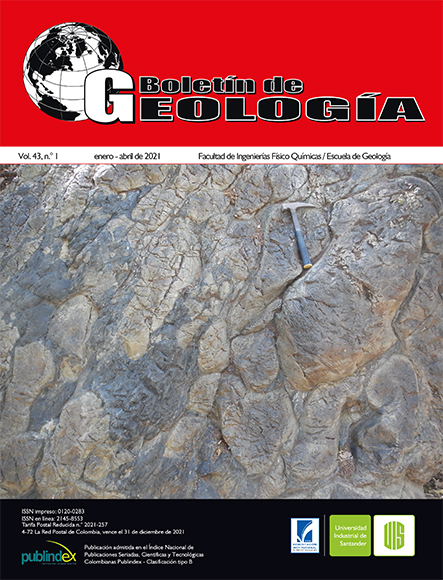Photoelectric factor (PEF) inferences in well logs with machine learning
Published 2021-01-07
Keywords
- Graph prediction,
- Attribute selection,
- Grid search,
- WEKA,
- Overfitting
How to Cite
Copyright (c) 2021 Boletín de Geología

This work is licensed under a Creative Commons Attribution 4.0 International License.
Altmetrics
Abstract
Conventional well logs are important for performing petrophysical analysis, seismic well ties and stratigraphic correlation. This study proposes a methodology to predict these types of logs using machine learning (ML), a tool highly applied in multiple disciplines. The training software used was WEKA (Waikato Environment for Knowledge Analysis), in which a model for the prediction of the Photoelectric Absorption log (PDPE) was generated, based on three attributes, the Gamma Ray log (GRGC), Density log (DEN) and Density Correction log (DCOR). This methodology was applied to well logs of San Fernando Formation, whose equivalent unit would be Mirador Formation, in the southwestern sector of the Llanos Basin, Colombia. Thirteen wells were used to train the model and six other wells were used to evaluate its performance. The results confirm the possibility of correlating logs that measure different characteristics in the rocks and show that inferences in well logs with ML require a detailed filtering to take the trend of the data, and a clear optimization to prevent overfitting in the model.
Downloads
References
Asquith, G.; Krygowski, D. (2004). Basic well log analysis. AAPG. Methods in Exploration Series, No 16.
Ballesteros, C.A.; Torres, C.A. (2017). Análisis conceptual del impacto de procesos térmicos de recobro mejorado, en completamientos convencionales y multiobjetivo con crudo extra-pesado en la Formación San Fernando, en la cuenca de los llanos Orientales. Tesis, Fundación Universidad de América, Bogotá, Colombia.
Brownlee, J. (2016). Machine Learning Mastery with Weka: Analyze Data, Develop Models, and Work Through Projects. Ebook Edition.
Dietterich, T. (1995). Overfiting and undercomputing in machine learning. ACM Computing Surveys, 27(3), 326-327. https://doi.org/10.1145/212094.212114
Drazin, S.; Montag, M. (2012). Decision tree analysis using weka. Machine Learning-Project II. University of Miami. Internal report.
El Naqa, I.; Murphy, M.J. (2015). What is Machine Learning? In: I. El Naqa; R. Li; M.J. Murphy (eds). Machine Learning in Radiation Oncology (pp. 3-11). Springer International Publishing. https://doi.org/10.1007/978-3-319-18305-3_1
Flores, R. (2014). Coalbed Gas Production. In: Coal and Coalbed Gas (pp. 369-436). Elsevier. https://doi.org/10.1016/B978-0-12-396972-9.00007-0
Glover, P. (2000). Petrophysics MSc Course Notes Wireline Logging Dr Paul Glover Page 59. Consultado el 4 de Noviembre del 2020. https://www.coursehero.com/fie/p46psk5/PetrophysicsMSc-Course-Notes-Wireline Logging-Dr-PaulGlover-Page-59-Data-is/
Hall, M.; Frank, E.; Holmes, G.; Pfahringer, B.; Reutemann, P.; Witten, I.H. (2009). The WEKA data mining software: an update. ACM SIGKDD Explorations Newsletter, 11(1), 10-18. https://doi.org/10.1145/1656274.1656278
Igbokwe, O.A. (2011). Stratigraphic interpretation of Well-Log data of the Athabasca Oil Sands of Alberta Canada through Pattern recognition and Artificial Intelligence. Master’s thesis. Westfälische Wilhelms-Universität Münster, Münster, Alemania.
Khandelwal, M.; Singh, T.N. (2010). Artificial Neural Networks as a valuable tool for well log interpretation. Petroleum Science and Technology, 28(14), 1381-1393. https://doi.org/10.1080/10916460903030482
Labani, M.M.; Kadkhodaie-Ilkhchi, A.; Salahshoor, K. (2010). Estimation of NMR log parameters from conventional well log data using a committee machine with intelligent systems: A case study from the Iranian part of the South Pars gas field, Persian Gulf Basin. Journal of Petroleum Science and Engineering, 72(1-2), 175-185. https://doi.org/10.1016/j.petrol.2010.03.015
Ochoa, L.H.; Niño, L.F.; Vargas, C.A.; (2018). Fast estimation of earthquake epicenter distance using a single seismological station with machine learning techniques. DYNA, 85(204), 161-168. https://doi.org/10.15446/dyna.v85n204.68408
Onajite, E. (2014). Understanding seismic interpretation methodology. In: Seismic Data Analysis Techniques in Hydrocarbon Exploration (pp. 177-211). Elsevier.
Parapuram, G.; Mokhtari, M.; Ben Hmida, J. (2018). An artificially intelligent technique to generate synthetic geomechanical well logs for the Bakken Formation. Energies, 11(3). https://doi.org/10.3390/en11030680
Piedrahita, J. (2016). Caracterización petrofísica de un área en el bloque CPO 16 en la cuenca de los Llanos Orientales – Colombia. Tesis, Universidad EAFIT, Medellín, Colombia.
Schlumberger Oilfild Glossary. Consultado el 26 de Diciembre del 2019. https://www.glossary.oilfild.slb.com/en/Terms/p/pef.aspx
Rojas, N.; Cardona, P.; Arango, S.; Florez, A. (2004). Redescubriendo un gigante: yacimiento San Fernando campo Chichimene - Cuenca Llanos orientales. III Convención Técnica ACGGP. Bogotá, Colombia.
Rolon, L.; Mohaghegh, S.D.; Ameri, S.; Gaskari, R.; McDaniel, B. (2009). Using artificial neural networks to generate synthetic well logs. Journal of Natural Gas Science and Engineering, 1(4-5), 118-133. https://doi.org/10.1016/j.jngse.2009.08.003
Wu, X.; Nyland, E. (1987). Automated stratigraphic interpretation of well-log data. Geophysics, 52(12), 1665-1676. https://doi.org/10.1190/1.1442283
Wu, P.Y.; Jain, V.; Kulkarni, M.S.; Abubakar, A. (2018). Machine learning-based method for automated well-log processing and interpretation. SEG Technical Program Expanded Abstracts 2018, 2041-2045. https://doi.org/10.1190/segam2018-2996973.1
Zhang, D.; Chen, Y.; Meng, J. (2018). Synthetic well logs generation via Recurrent Neural Networks. Petroleum Exploration and Development, 45(4), 629-639. https://doi.org/10.1016/S1876-3804(18)30068-5

